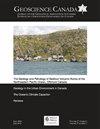Great Canadian Lagerstätten 6. Mistaken Point Ecological Reserve, Southeast Newfoundland
IF 0.8
4区 地球科学
Q3 GEOSCIENCES, MULTIDISCIPLINARY
引用次数: 8
Abstract
Mistaken Point Ecological Reserve (MPER) World Heritage Site, on the southeastern coast of Newfoundland, Canada, is one of the foremost global Ediacaran fossil localities. MPER contains some of the oldest known assemblages of the soft-bodied Ediacaran macrobiota, and its fossils have contributed significantly to Ediacaran paleobiological research since their initial discovery in 1967. Preservation of multiple in situ benthic paleocommunities, some comprising thousands of specimens, has enabled research into Ediacaran paleoecology, ontogeny, taphonomy, taxonomy and morphology, offering insights into the possible phylogenetic positions of Ediacaran taxa within the tree of life. Meanwhile, a thick and continuous geological record enables the fossils to be placed within a well-resolved temporal and paleoenvironmental context spanning an interval of at least 10 million years. This article reviews the history of paleontological research at MPER, and highlights key discoveries that have shaped global thinking on the Ediacaran macrobiota.RESUMELe site du Patrimoine mondial de la Reserve ecologique de Mistaken Point (MPER), sur la cote sud-est de Terre-Neuve, au Canada, est l'une des principales localites fossiliferes ediacariennes de la planete. Le MPER renferme quelques-uns des plus anciens assemblages connus de macrobiote edicarien a parties molles, et ses fossiles ont contribue de maniere significative a la recherche paleobiologique ediacarienne depuis leur decouverte en 1967. La preservation de multiples paleocommunautes benthiques in situ, dont certaines comptant des milliers de specimens, a permis de faire des recherches en paleoecologie, ontogenese, taphonomie, taxonomie et morphologie de biotes ediacariens, ce qui a permis d’avoir un apercu de differentes positions phylogenetiques possibles des taxons ediacariens dans l'arborescence biologique. Aussi, grâce a une colonne geologique epaisse et continue, on a pu placer ces fossiles dans un contexte temporel et paleoenvironnemental bien circonscrit qui s’etend sur un intervalle d'au moins 10 millions d'annees. Cet article passe en revue l'histoire de la recherche paleontologique au MPER et souligne les decouvertes majeures qui ont faconne la reflexion sur le macrobiote ediacarien.伟大的加拿大人拉格斯泰滕6。纽芬兰东南部的Misten Point生态保护区
加拿大纽芬兰东南海岸的错误点生态保护区(MPER)世界遗产地是全球最重要的埃迪卡兰化石遗址之一。MPER包含一些已知最古老的软体埃迪卡兰大型生物群,其化石自1967年首次发现以来,对埃迪卡兰古生物学研究做出了重大贡献。保护多个原位底栖古群落,包括数千个标本,已对Ediacaran古生物学、个体发生学、taphonomy、分类学和形态学进行了研究,为生命树中EdiacaranTaxa的可能系统发育位置提供了见解。同时,一项厚厚且持续的地质记录使化石能够放置在解决良好的时间和古环境环境中,间隔至少1000万年。本文回顾了MPER古生物学研究的历史,并强调了塑造全球对埃迪卡兰大型生物群思考的关键发现。加拿大纽芬兰东南海岸的Mistaken Point生态保护区(MPER)是世界上最重要的埃迪卡里亚化石遗址之一。MPER包含了一些已知最古老的软体埃迪卡里亚大型生物群组合,自1967年发现以来,其化石对埃迪卡里亚古生物学研究做出了重大贡献。在原位保存了许多底栖古群落,其中一些包含数千个标本,这使得有可能对埃迪卡里亚生物群的古生态学、个体发育学、taphonomie、分类学和形态学进行研究,从而深入了解埃迪卡里亚分类群在生物树中可能的不同系统发育位置。此外,由于一个厚而连续的地质柱,这些化石被放置在一个明确界定的时间和古环境背景中,其范围至少为1000万年。本文回顾了MPER古生物学研究的历史,并强调了影响埃迪卡利亚大型生物群反思的主要发现。
本文章由计算机程序翻译,如有差异,请以英文原文为准。
求助全文
约1分钟内获得全文
求助全文
来源期刊

Geoscience Canada
地学-地球科学综合
CiteScore
3.30
自引率
0.00%
发文量
9
审稿时长
>12 weeks
期刊介绍:
Established in 1974, Geoscience Canada is the main technical publication of the Geological Association of Canada (GAC). We are a quarterly journal that emphasizes diversity of material, and also the presentation of informative technical articles that can be understood not only by specialist research workers, but by non-specialists in other branches of the Earth Sciences. We aim to be a journal that you want to read, and which will leave you better informed, rather than more confused.
 求助内容:
求助内容: 应助结果提醒方式:
应助结果提醒方式:


